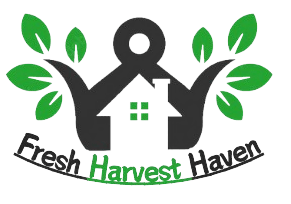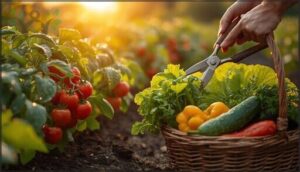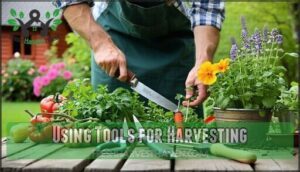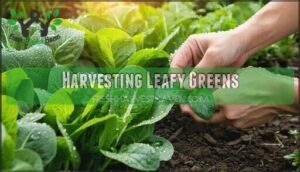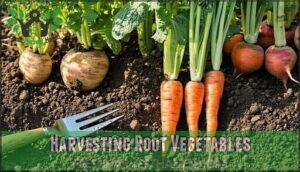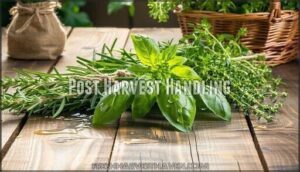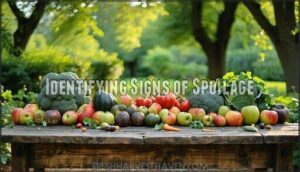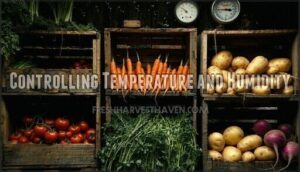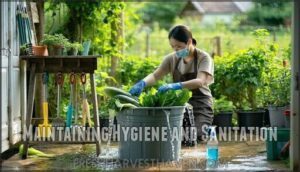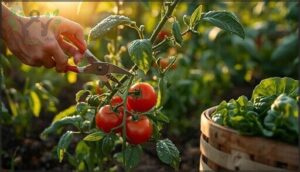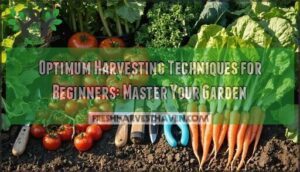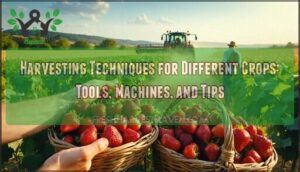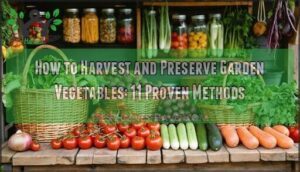This site is supported by our readers. We may earn a commission, at no cost to you, if you purchase through links.
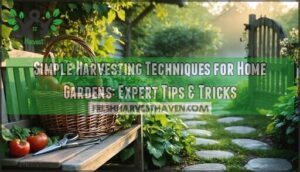 Mastering simple harvesting techniques for home gardens starts with timing and tools.
Mastering simple harvesting techniques for home gardens starts with timing and tools.
Harvest in early morning when plants are crisp and hydrated.
Use clean, sharp tools to prevent disease spread and plant damage.
Pick fruits when they give slightly to pressure but aren’t mushy.
Cut leafy greens with scissors rather than pulling to keep roots intact for regrowth.
For root vegetables, gently loosen soil first to avoid breaking them.
Handle produce carefully – bruised vegetables spoil faster.
Store different crops at their preferred temperatures immediately after harvesting.
These basics transform your garden from amateur picking to professional results.
The real magic happens when you learn each crop’s unique signals.
Mastering these techniques requires attention to detail and careful handling of produce.
Table Of Contents
- Key Takeaways
- Harvesting Best Practices
- Crop Specific Techniques
- Post Harvest Handling
- Preventing Spoilage Methods
- Maximizing Harvest Yield
- Frequently Asked Questions (FAQs)
- What is the easiest crop to harvest?
- What are some harvesting techniques?
- How to harvest from your garden?
- What is one strategy for getting more produce out of a small garden?
- What is the easiest plant to harvest?
- What are the three most common harvesting methods?
- How do I plan my harvest time?
- How should vegetables be harvested?
- What are the best practices for harvesting a variety of fruits & vegetables?
- How do you make your harvest truly rewarding?
- Conclusion
Key Takeaways
- Harvest in the morning when plants are crisp and hydrated – You’ll capture peak sweetness and moisture content while preventing wilting and disease spread that occurs in warmer afternoon temperatures.
- Use clean, sharp tools and handle produce gently – You’ll prevent disease transmission between plants and avoid bruising that causes faster spoilage during storage.
- Pick at the right ripeness stage for each crop – You’ll get better flavor by harvesting fruits when they give slightly to pressure and cutting leafy greens with scissors to keep roots intact for regrowth.
- Store harvested produce at proper temperatures immediately – You’ll extend shelf life significantly by controlling temperature and humidity levels specific to each crop type.
Harvesting Best Practices
Perfect timing makes all the difference when harvesting your homegrown produce.
You’ll get the best flavors and longest storage life by following three key practices that protect both your plants and your harvest.
Morning Harvesting Benefits
Morning harvest transforms your garden experience into something special. This golden window offers your plants’ peak sweetness from overnight starch-to-sugar conversion while ideal moisture content creates perfect harvesting conditions.
Morning’s magic turns your garden into nature’s sweetest treasure chest.
Harvest in the morning for peak flavor, reduced wilting, and to capture the freshest, sweetest produce your garden offers.
Smart morning collection delivers these harvesting tips benefits:
- Peak sweetness emerges as plants convert starches overnight into natural sugars
- Reduced wilting occurs because cool temperatures preserve plant structure
- Ideal moisture content maintains vegetable firmness without excess water
- Disease prevention happens when you beat the midday heat that spreads pathogens
- Flavor capture works best before essential oils evaporate in rising temperatures
Your garden harvest timing makes all the difference. These proven harvesting techniques for harvesting vegetables guarantee you’ll taste the difference that morning brings to your table.
Avoiding Wet Harvesting
Timing your harvest right means more than picking at peak ripeness. You need to wait for dry conditions to protect your plants from disease transmission and guarantee longer storage life.
Wet plants create perfect conditions for trouble. Water acts like a superhighway for germs that slip through harvest wounds and spread throughout your garden.
Morning harvest beats afternoon heat—crisp vegetables stay fresh longer when picked cool and dry.
Smart home garden harvest practices protect your investment. These harvesting techniques prevent bacterial spread and fungal growth while maintaining ideal humidity levels for your produce. Morning collection works best after dew impact fades and surfaces dry completely for effective disease prevention. This approach ensures longer storage life and helps in preventing bacterial spread, ultimately leading to healthier plants and better crop yields.
Cleaning Harvesting Tools
While wet harvesting spreads disease, dirty tools create the same problem.
Keep your cutting tools clean to protect your plants from harmful bacteria and pathogens.
Here’s your tool maintenance checklist:
- Sanitize between plants – Wipe blades with a 10% bleach solution ratio or rubbing alcohol
- Sharp tools work better – Regular sharpening blade benefits include cleaner cuts that heal faster
- Dry thoroughly – Proper drying tool importance prevents rust and extends tool life
- Store smart – Keep tools in dry places for effective rust prevention methods
Clean tools mean healthy harvests every time.
Using tools with ergonomic handle designs can also help prevent hand strain.
Crop Specific Techniques
Different crops need different harvesting methods to get the best results from your garden.
You’ll learn specific techniques for picking fruits, using tools properly, gathering leafy greens, and pulling root vegetables at the right time.
Hand-Picking Fruits and Vegetables
Handpicking requires gentle handling and recognizing ripeness indicators for ideal results.
Use gentle plucking motions with sufficient pressure to prevent damage during fruit harvesting. For tomatoes, cradle the fruit and twist gently rather than pulling straight down. Peppers respond well to quick stem snaps.
Bruising prevention starts with supporting heavy fruits like melons while detaching them. Practice staggered harvesting by picking fruits at different stages, allowing others to ripen.
Watch for color changes and slight softening as key ripeness indicators before beginning your vegetable harvesting.
Using Tools for Harvesting
Right harvesting tools transform your garden work from back-breaking to breeze-worthy. Sharp knives guarantee clean cuts that heal faster, while pruning shears tackle woody stems with precision.
Your toolkit makes all the difference:
- Scissors for delicate herbs and greens
- Specialized tools like digging forks for root vegetables
- Ergonomic tools that reduce hand fatigue during big harvests
Tool maintenance keeps everything running smoothly. Blade sharpness prevents plant damage, and tool sanitation with diluted bleach stops disease spread. A garden knife handles multiple jobs perfectly. You can find a wide variety of specialized garden tools online.
Harvesting Leafy Greens
Leafy greens reward you with the best flavors when you harvest them correctly. The thumb-nail method works perfectly for tender greens like arugula and spinach—just pinch leaves near the base using your fingernail. This gentle approach prevents damage and keeps plants producing.
Leafy greens thrive when harvested with care—pinch tender leaves or snip outer ones for continuous, flavorful yields from your garden.
For cut-and-come-again harvesting, snip outer leaves first while letting inner ones mature. This technique extends your harvest season substantially.
The thumb-nail harvest method keeps greens fresh and thriving—pinch leaves gently near the base for endless garden goodness.
Morning harvest captures flavor peaks when essential oils are strongest. Most leafy greens and harvesting herbs should happen before 10 AM. Proper leaf selection and outer leaf removal guarantee multiple harvests. These simple harvesting techniques work for lettuce, kale, and herbs alike.
Harvesting Root Vegetables
Root vegetables reward patience with perfect results. Check for mature shoulders peeking through soil before harvesting.
Follow these key steps for success:
- Test soil moisture—avoid muddy or bone-dry conditions
- Loosen soil around carrots and beets with a fork
- Pull potatoes after plant tops die back completely
- Brush off excess dirt before storing
Proper digging techniques prevent damage and guarantee your storage methods keep harvests fresh for months.
Post Harvest Handling
After harvesting your garden’s bounty, proper handling guarantees your hard work doesn’t go to waste.
Clean sorting and correct storage methods will keep your produce fresh and flavorful for weeks to come, which is the key to making the most of your garden’s bounty.
Cleaning and Sorting Produce
After bringing your fresh harvest inside, start your cleaning and sorting produce routine with quality wash water.
Rinse each item under cool running water while checking for damage.
Damage assessment helps you spot bruises or disease early.
Sorting by size makes storage easier and guarantees even ripening.
Produce sanitization keeps your harvest fresh longer.
| Sorting Category | What to Look For | Next Steps |
|---|---|---|
| Perfect Quality | No bruises or spots | Store for later use |
| Minor Damage | Small cuts or scratches | Use within 1-2 days |
| Overripe | Soft spots appearing | Cook or preserve today |
| Damaged | Major bruising or rot | Compost immediately |
| Undersized | Too small for harvest | Return to garden |
Proper hygiene during this process protects produce quality and extends shelf life through careful storage preparation.
Drying and Storing Harvested Crops
Success depends on mastering proper storage methods that preserve your harvest’s quality and extend shelf life. Different crops demand specific approaches to maintain freshness and prevent spoilage.
Essential dehydration methods and storage principles include:
- Temperature and humidity control – maintain 50-70°F with humidity below 60% to prevent mold
- Proper drying methods like sun drying, oven drying at 130-140°F, or dehydrators for consistent results
- Root cellaring for long-term storage of potatoes, carrots, and other root vegetables in cool, dark spaces
- Canning safety protocols and fermentation techniques for preserving surplus produce beyond fresh consumption.
Airtight containers extend storage life up to twelve months. Seed saving requires complete drying before sealed storage to maintain viability for next season’s planting. Ethylene production matters as it can accelerate spoilage in nearby vegetables.
Packaging for Transportation
After properly drying and storing your harvest, you’ll need smart Protecting Produce strategies for transport. Your homegrown treasures deserve gentle handling from garden to kitchen.
Choose the right basket size for your load. Pack strategically to prevent bruising prevention mishaps. Temperature Control matters during longer trips. Sustainable Materials like reusable containers offer Cost Efficiency over time.
Consider the ideal container dimensions for efficient packing.
Here’s your damagefree packing playbook:
- Layer soft cloth in baskets to cushion delicate produce
- Place heavy items below, fragile ones above for Reducing Damage
- Maintain airflow with ventilated containers
- Use mesh bags for breathable, eco-friendly transport
Preventing Spoilage Methods
You can’t enjoy your fresh harvest if it spoils before you eat it.
Learning to spot early warning signs and control storage conditions will keep your homegrown produce fresh for weeks instead of days.
Identifying Signs of Spoilage
Learning to spot spoilage starts with trusting your eyes. Look for mold detection signs like white, green, or black growth on surfaces. Check for fruit decay through dark spots, bruising, and unusual blemishes that signal problems ahead.
Your nose knows best—strange odors reveal vegetable rot before your eyes catch up. Touch tells the story too. Fresh produce feels firm while spoiled items turn mushy or slimy. These ripeness indicators help you separate keepers from compost candidates.
Quick spoilage prevention starts with daily checks during harvest season. Understanding disease prevention methods is essential for maintaining healthy plants and reducing spoilage. Check out disease prevention methods to learn more about keeping your plants healthy. Fresh produce and healthy plants are key to minimizing waste and maximizing your harvest. By following these tips, you can enjoy a bountiful harvest with minimal spoilage and waste.
Controlling Temperature and Humidity
Your harvest’s future hinges on mastering storage temperature and humidity levels. Each crop demands specific ideal conditions to prevent rapid deterioration.
Create the perfect environment with these essential steps:
- Set your refrigerator storage to 32-40°F for most vegetables
- Maintain 85-95% humidity using perforated bags or damp towels
- Guarantee proper ventilation methods to prevent moisture buildup
- Monitor conditions weekly using simple thermometers and hygrometers
Proper temperature control extends shelf life dramatically. Root vegetables thrive in cool, moist conditions while onions need dry storage.
Effective spoilage prevention methods depend on matching your storage conditions to each crop’s needs. Accurate temperature control systems are vital for maintaining ideal storage environments.
Maintaining Hygiene and Sanitation
Clean hands and sanitizing tools between plants stops disease spread throughout your garden.
Your harvesting guide should include proper tool sanitation using alcohol or bleach solutions.
Hand hygiene prevents contamination when cleaning produce after harvest.
Sterilization methods protect your crops during postharvest care.
Keep baskets and storage containers debris-free for effective garden sanitation.
Washing harvested crops before storing removes harmful pathogens that cause spoilage.
Maximizing Harvest Yield
You’ll boost your garden’s productivity by using smart harvesting methods that encourage plants to keep producing throughout the season.
These simple techniques help you get more food from the same space while keeping your plants healthy and strong.
Extending Vegetable Yields
Three strategies maximize your vegetable yields through smart garden planning.
Succession planting creates continuous production by sowing crops every two weeks.
Plant early, mid-season, and late varieties simultaneously for extended harvests.
Crop rotation and soil enrichment boost plant health naturally.
Use vegetable pruning to encourage bushier growth.
Implement proper harvesting techniques like cut-and-come-again methods for leafy greens.
These yield optimization practices transform small spaces into productive powerhouses that deliver fresh produce throughout the growing season.
By incorporating effective soil health strategies, gardeners can substantially improve their overall harvest quality and quantity.
Enhancing Crop Visibility and Accessibility
Smart crop mapping transforms harvest time into a backyard harvest adventure. Map your garden layout with clear pathway design between rows so you can navigate without stepping on plants. Use crop labeling to identify varieties quickly during simple harvest rounds.
Consider these accessibility tools for effortless handpicking techniques:
- Install raised bed markers for easy plant identification
- Create wide walkways between crop sections for comfortable movement
- Use colorful plant stakes to mark harvest-ready vegetables
- Position harvest baskets strategically throughout garden rows
Proper spacing lets air circulate while keeping crops visible. You’ll spot hidden treasures behind leaves and reach every plant without stretching. This organized approach makes each harvest session smooth and productive, allowing for a more enjoyable gardening experience with clear pathway design.
Implementing Sustainable Harvesting Practices
Your garden’s accessibility sets the stage for earth-friendly Sustainable Methods.
Eco Friendly practices like using manual tools instead of gas-powered equipment reduce your carbon footprint.
Harvest Timing with selective picking prevents overuse of soil nutrients.
Crop Rotation maintains plant health while Soil Conservation techniques preserve growing conditions.
| Sustainable Practice | Garden Benefit |
|---|---|
| Manual harvesting tools | Reduces emissions |
| Rainwater collection | Conserves water |
| Selective picking cycles | Maintains soil health |
| Compost application | Enriches nutrients |
These sustainable gardening and harvesting techniques create productive garden maintenance systems.
Smart vegetable harvesting with ecofriendly practices maximizes yields naturally.
Frequently Asked Questions (FAQs)
What is the easiest crop to harvest?
Leafy greens like lettuce are easiest to harvest.
You’ll simply pinch or cut outer leaves while leaving inner ones to grow.
They’re forgiving and regrow quickly for multiple harvests throughout the season.
What are some harvesting techniques?
When Sarah snipped lettuce leaves at dawn, she noticed they stayed crisp longer than afternoon harvests.
You’ll harvest best using sharp, clean tools during cool morning hours when plants hold peak moisture and sweetness.
How to harvest from your garden?
Harvest early morning when plants hold peak moisture and sweetness. Use clean, sharp tools to make precise cuts that heal quickly. Pick frequently to encourage continued production and prevent overripening.
What is one strategy for getting more produce out of a small garden?
Turn your garden into a treasure chest by practicing cut-and-come-again harvesting with leafy greens.
You’ll harvest outer leaves first while inner leaves continue growing, giving you multiple harvests from one plant throughout the season.
What is the easiest plant to harvest?
Lettuce tops the list as your easiest harvest. You’ll simply pinch outer leaves when they’re young and tender, leaving the center to keep growing for multiple harvests.
What are the three most common harvesting methods?
Like three tools in a gardener’s toolbox, you’ll master cutting, pinching, and snapping.
Cut stems with sharp tools for clean wounds.
Pinch tender leaves between thumb and nail.
Snap brittle vegetables at their natural break points.
How do I plan my harvest time?
Check plant maturity daily in early morning when sugar content peaks. Harvest vegetables small and tender, fruits fully ripe on the vine. Pick frequently to encourage continued production.
How should vegetables be harvested?
Use clean, sharp tools to harvest vegetables in the morning when they’re crisp and flavorful. Cut or pinch at the right spots to avoid damaging plants and encourage continued growth.
What are the best practices for harvesting a variety of fruits & vegetables?
Harvest in early morning when plants hold peak sweetness and moisture.
Use clean, sharp tools to make precise cuts.
Pick vegetables small for tenderness, fruits when fully ripe, and leafy greens by outer leaves first, to ensure peak sweetness and quality.
How do you make your harvest truly rewarding?
Peak timing, proper technique, and daily attention transform ordinary gardening into abundant harvests that nourish both body and soul through seasons of plenty.
Conclusion
Research shows that home gardeners waste 40% of their harvest due to improper timing and handling.
However, mastering simple harvesting techniques for home gardens transforms your garden into a productive food source. You’ll enjoy fresher produce that lasts longer when stored properly.
Remember to harvest during cool morning hours and use clean tools for each crop. Handle your vegetables gently to prevent bruising.
These fundamental techniques guarantee maximum yield and quality from your garden investment, ensuring you get the most out of your garden investment.
- https://morningchores.com/harvesting-your-garden/
- https://savvygardening.com/harvesting-vegetables/
- https://forksinthedirt.com/water-wise-harvesting-from-your-garden/
- https://ucanr.edu/blogs/blogcore/postdetail.cfm?postnum=20754
- https://www.hgtv.com/outdoors/gardens/garden-styles-and-types/15-harvesting-tips-for-edibles-pictures
